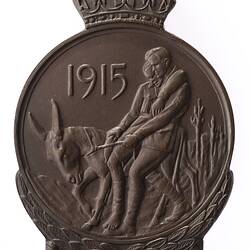Summary
Anzac commemorative medallion (in case) awarded to Cpl. Albert Victor Peile in 1967 to mark the 50th anniversary of Gallipoli.
Corporal Albert Peile joined on 27 August 1914 when he was 22 years old and served with the 3rd Battalion, D Company. His parent's were John and Mary Agnes Peile. Albert served in Gallipoli and later France, and was eventually promoted to the rank of corporal. He died in Bullecourt, France on 4 May 1917 and is commemorated at the Villers-Bretonneux Memorial.
In March 1967 the Prime Minister, the Rt. Hon. Harold Holt, announced that a commemorative medallion and badge was to be issued to surviving members of the Australian Defence Force who served on the Gallipoli Peninsula, or in direct support of the operations from close off shore, at any time during the period from the first Anzac Day in April 1915 to the date of final evacuation in January 1916. The medal was also available to the families of eligible personnel who had died before 1967, either in conflict or in the years following.
The Gallipoli Commemorative medal was designed by the Australian artist Raymond Ewers and endorsed by both the Australian and New Zealand Governments. The medal depicts Simpson and his donkey carrying a wounded soldier with the word 'ANZAC' bordered by a laurel wreath in the bottom section on the obverse. The reverse of the medal shows a map of Australia and New Zealand and the Southern Cross, the bottom half is bordered by New Zealand ferns. It is also on the reverse that the awardee's name was inscribed.
Albert's war record states that the medal was requested by his niece, Mrs Margaret Joan Hitchens, in May 1967, with the consent of Albert and his brother John's only surviving sister, Eva. Margaret also requested a Gallipoli Commemorative Medal for Albert's brother, John. Margaret (1916-?) was the daughter of Albert and John's sister Alice and her husband John Henry Dinwoodie.
Albert's brother was Corporal John Peile, service number 2662. He was born in Echuca, Victoria and was an unmarried miner when he joined on 25 June 1915, at the age of 38. He served in the 2nd Battalion, AIF, in Gallipoli and France. He died in France on 18 September 1918 and is buried at Roisel Communal Cemetery Extension, France (III. H. 9).
Physical Description
A circular bronze medal with crown at top and wreath and plaque at base in box of issue. The obverse featured Simpson and his donkey carrying a wounded soldier to safety; in the field above, 1915; the wreath below is laurel and the plaque carries the word, ANZAC. The reverse depicts a relief map of Australia and New Zealand with the Southern Cross superimposed; the wreath below is a New Zealand Fern and the plaque is engraved A.V. PEILE
Obverse Description
A circular bronze medal with crown at top and wreath and plaque at base. At centre, Simpson and his donkey carrying a wounded soldier to safety; in the field above, 1915; the wreath below is laurel and the plaque carries the word, ANZAC.
Reverse Description
A circular bronze medal with crown at top and wreath and plaque at base. A relief map of Australia and New Zealand with the Southern Cross superimposed; the wreath below is a New Zealand Fern and the plaque is engraved A.V. PEILE
Edge Description
Plain
Significance
A commemorative medallion and badge was to be issued to surviving members of the Australian Defence Force who served on the Gallipoli Peninsula, or in direct support of the operations from close off shore, at any time during the period from the first Anzac Day in April 1915 to the date of final evacuation in January 1916.
More Information
-
Collection Names
-
Collecting Areas
-
Acquisition Information
Donation from Victorian Branch, Returned & Services League of Australia Limited (RSL), Mrs Margaret J. Hitchens, 1986
-
Date Issued
1967 AD
-
Issued By
-
Person Commemorated
Corporal Albert V. Peile - Australian Imperial Force (AIF), Australia
-
Artist
-
Designer
-
Place
Gallipoli Peninsula, Turkey, 1915
Place & date commemorated -
Inscriptions
A.V. PEILE 1915 ANZAC
-
Material
Bronze
-
Axis
12
-
Classification
-
Category
-
Discipline
-
Type of item
-
Overall Dimensions
50 mm (Width), 75 mm (Height)
Box 82 x 95 mm black
-
Shape
Round with crown at top
-
References
References: Australian War Memorial website; [Link 1]
-
Keywords
Anzac Day, Commemorations, Wars & Conflicts, World War I, 1914-1918



